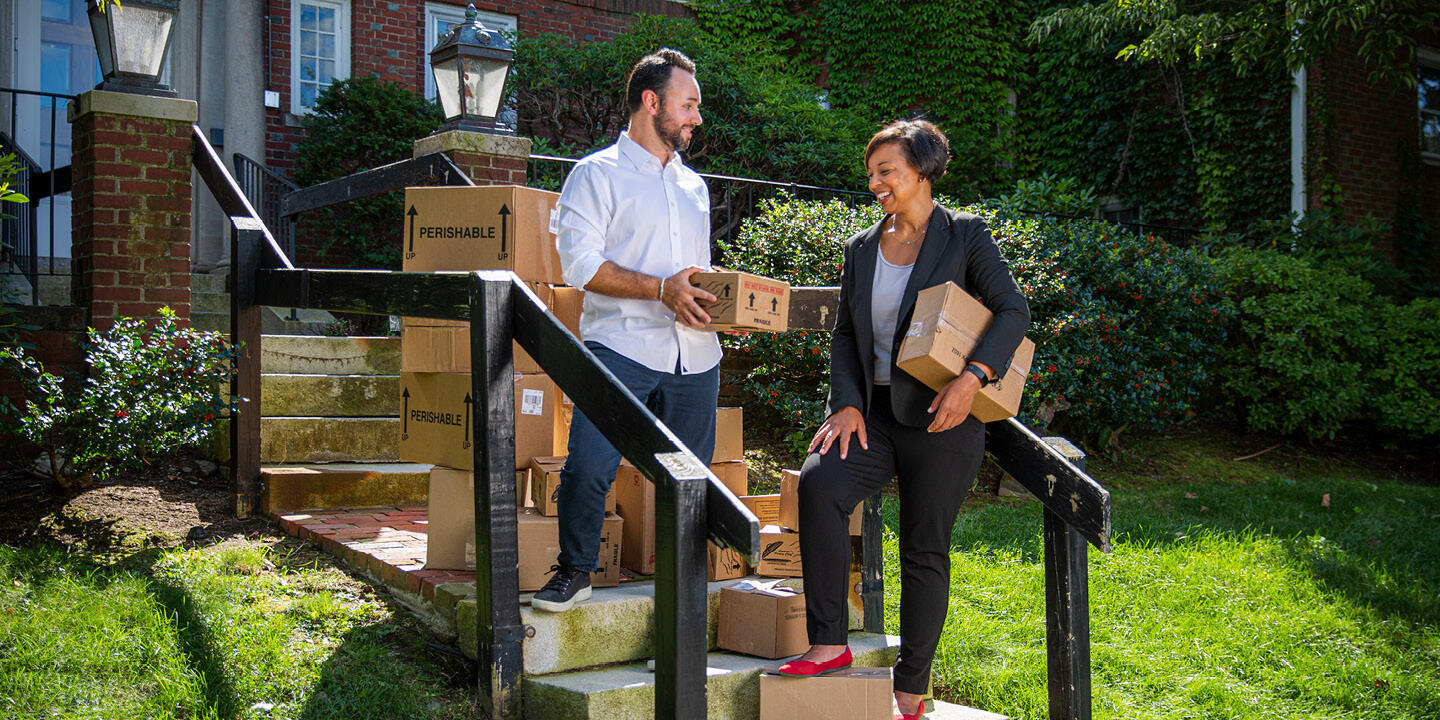
Take Two: Commerce + COVID
The pandemic changed the way that people shop and companies sell. Brandon Hendrix ’06 and faculty member Shelle Santana trade insights on which online buying habits and marketing strategies are likely to stick.
What are the biggest changes in consumer behavior during COVID-19?
Brandon Hendrix: It feels like trends have accelerated by decades — and you can see that through e-commerce growth curves. People who were not accustomed to buying online were forced into it much faster than they normally would have been. Considering my own habits, I never used to buy groceries online and have them delivered, but it’s so convenient that now I almost don’t want to go grocery shopping in person.
Shelle Santana: COVID sped up consumers’ use of non-cash payments. For example, the payment processing company Square found that, within its customer base, the pandemic accelerated the adoption of digital payments by three years. That is coupled with changes in how people shop for things. Pre-COVID, we talked a lot about “omnichannel consumers,” who connected with brands through many different channels, across the web or in a brick-and-mortar store. The pandemic really brought that to life. I’m now an Instagram shopper extraordinaire.
How did retail companies adapt marketing strategies and messaging to reach consumers?
SS: Health and safety were on the forefront of communications. Nearly every brand sent emails to their customer base about the actions being taken to keep employees and customers safe — from limiting the number of shoppers in a store to requiring everyone to wear masks. The message was clearly, “We’re in this together and we’re going to do our part to help keep our community safe.”
I think consumers really valued that. Flexibility, particularly by online providers, was also important — making products easy to shop for, easy to have shipped to your home and easy to return. Companies have realized that, without the benefit of trying things on or having that tactile experience, people are guessing on their purchases. So we’re seeing much more generous return policies.
BH: A lot of e-commerce companies are trying to figure out how to engage with consumers’ sensory feelings — the emotional response of how a leather shoe would feel, for example. There are now better chat functions so questions are answered in real time. Many companies also had to speed up third-party logistics to try to improve shipping capabilities. Before, you could almost always walk into a Peloton store and have one of their exercise bikes shipped that week, but during COVID there was a three-month wait.
Are the changes temporary, permanent or both?
BH: When you’re trying to form a habit, like exercise, you might commit for 30 days because it’s more likely to stick with repetition. With COVID we were all locked down for six to 12 months, so our psychology was changing. We formed new online shopping behaviors, like clicking on Instagram ads and buying things, when we never had before. You could order 12 pairs of shoes and just return 11 of them.
From a seller standpoint, a lot of traditional retailers may move to a showroom-style platform where consumers go to a store and try something on, then it’s shipped to them. Online advertising and marketing on platforms like Facebook and TikTok are growing faster than they would have if COVID had not happened. How people discover and shop for products is going to be different.
SS: Looking at how consumers have changed their payment preferences, I’d say this shift is permanent-ish. That is, the overall trend toward more cashless transactions is permanent, but I wouldn’t be surprised if some segments of consumers drift back to a mix of cash and credit or cash and non-cash payments.
Were there changes that especially surprised you?
BH: I was surprised by the sheer increase in volume within some categories like fitness products. That had a direct impact on the supply chain. Companies often could not predict fast enough how much supply they needed; those that could were in a much better position. New businesses with lower sales are feeling the most impact, as the world’s largest manufacturer — China — pushes its production to large and established vendors.
Are large-scale changes necessary with these shifts in consumer behavior?
SS: A long-term issue with cashless transactions is that individual differences impact consumers’ ability to pay electronically. Lower-income or older consumers may have less access to or comfort with the resources that enable non-cash payments, like credit cards and the internet.
BH: We need to find better ways for those communities to get access to banks or offer two forms of payment to buy things online, especially in cases where physical locations for necessities like groceries shut down. It’s something that people don’t talk about very often.
Is brand loyalty important in the current landscape?
BH: Online, there are so many options it can be hard for consumers to know what‘s legitimate and what’s not. Products may have thousands of positive reviews, and everything works out fine. But at some point you might need something to hold on to — like a brand that has been around for a while.
SS: Brand loyalty is even more important in the COVID era because competition is just a few clicks away. Competitors are able to reach your same customer group by running algorithms. It’s so easy for a consumer to compare products and prices; so easy to find the next best thing.
Meet the Experts

Brandon Hendrix ’06 is senior vice president of marketing and a founding team member at Thrasio, which buys and grows businesses that sell goods on Amazon. One of the fastest-growing companies in U.S. history, Thrasio has raised $2.3 billion in funding and reached unicorn status in fewer than three years.

Assistant Professor of Marketing Shelle Santana is an expert in consumer behavior and decision-making. Her research focuses on behavioral pricing and the psychology of money, including the trajectory of changing payment methods.

